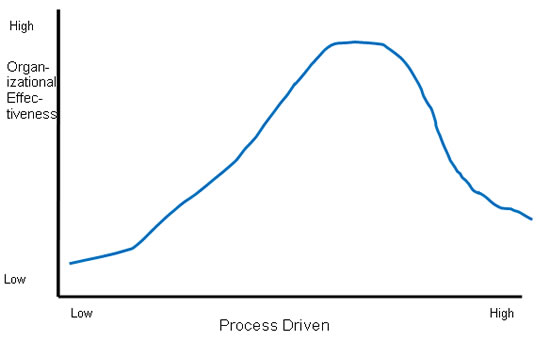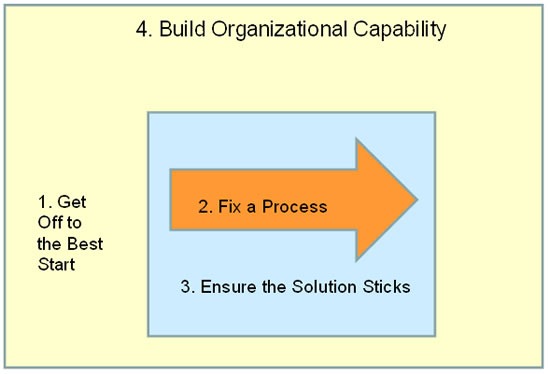When you are trying to handle a problem, make an improvement, change the culture, or implement a key strategy where do you go first – to manage the people or manage the process?
Consider these four scenarios. Would you approach the situation by managing the people or managing the process? Rate each one against the 5 criteria and think about why you selected the rating. We will come back to these four scenarios at the end at the end of the article and consider them further.
![]()
We have laid off people because of the recession and now employees and managers are overwhelmed with work.
We have some really good people in a few of our financial groups, but others in different regions are not as good.
Customers are telling us our customer service is poor- we can’t answer their questions and it takes too long.
The customer says our product doesn’t fit their needs and is not as good as our competitors.
Based on this short self-inventory you probably know if you predominately “manage the people” or “manage the process”. Many would say that Jim Collins (one of the great leadership thought leaders of our time) subscribes to a ‘manage the people’ approach. In his book, Good to Great, he articulates three principles that underlie great companies:
Disciplined People – a company must have focused leadership with vision. Moreover, the most important element for building and maintaining a great company is getting the right people ‘on the bus’– first who, then what.
Disciplined Thought
– a company must “face the brutal facts” about the marketplace about the numbers, not befool itself and then take action. It must operating model on three intersecting circles – what the company is best at, what they are passionate about, and what drives their economic model.
Disciplined Action
– (1) disciplined thought, actions, and responsibilities and (2) continually pushing forward.
The first principle, Disciplined People, gets a 1 rating above, almost exclusively people. Clearly if an organization doesn’t have strong leaders and doesn’t carefully choose smart and dedicated employees it will be working with both hands tied behind its back. That’s why so many start-ups can be successful with the right founders and initial employees. It’s why Steve Jobs can come back to Apple and get the company back on track.
The second principle is about focus, direction, and using quantitative data. That sounds like a combination of people and process, maybe at the 3 rating. The brutal facts can come from measuring process, assessing the environment, and hearing from people (executives, customers, employees, and the market). The three circles speak to having clear guiding lights to drive where the company is going. What you are best may be innovation, customer delight, or execution, and these all depend on people and process. What you are passionate about is about values and attitude and is heavily people. The economic model is a financial process of recording how the company is doing and facing the brutal facts.
The third principle, Disciplined Action, is about process and getting people to do the process through understanding their responsibilities and taking action. In a smaller company it is accomplished informally through collaboration and problem solving. In a larger company it is probably accomplished through managing work and information process and people knowing their roles, how they affect customers and outcomes. I would rate this a 4 or 5.
Now if we move to looking at the process side, it’s a good idea to evaluate how much of a process driven organization you are by putting your company (or your division or function) on the following chart.
Where is Your Organization?
 |
Is your company far to the left with very little attention to process and not benefiting from the organizational effectiveness it can bring? Alternatively, is it somewhere up the rising slope of the curve where you are paying attention to processes, seeing the results in the business, but could still do more? Lastly is your organization somewhere to the right of the graph, past the high point, where you are overly ‘process driven’ and it seems that many tasks involve burdensome processes to get work done?
What are the critical elements to building a process driven organization that produces results? There are four.
 |
Get Off to the Best Start
– by selecting processes that are important to the business (the customer, the financials) and ones that are needing emphasis right now, because there is a burning platform—in some what they are underperforming. This element rates a 4 or 5.
Fix the process
– (1) which may be easy and you can model it, and analyze it and find quick wins that make the improvements you need. (2) by doing a process improvement effort which could last from 3-12 months with modeling, analysis, redesign, and implementation, or (3) using process innovation which would imply a larger scope, new technology, working more end to end with outside suppliers and partners. Each has different levels of return, with the first being the quickest but smallest and the third takes the longest but has greatest impact. This rating is a 4- it concentrates on process but need people to bring expertise and analysis.
Ensure the Solution Sticks
– I use a core process team of cross – unit subject matter experts, executive sponsor, internal facilitator, project lead, IT, Maverick, data person, and sometimes customers and suppliers. This team does the modeling, analysis, redesign, and the sponsor and project lead are responsible for successful implementation. They are involved throughout and so go from initiation to completion, while involving other stakeholders with an engagement plan. I think this is a 3 rating. Indeed engaging people in a significant way in process improvement makes it have more impact.
Build Organizational Capability
– There are many aspects needed here, but four have been critical in my work with corporations:
- Sharing successes with executives and the organization
- Using visible metrics for continuous improvement action
- Nurturing and internal facilitator network
- Building leader and employee process capability
This element is a 2 or 3 rating.
So how do you decide whether to manage the people or manage the process? The chart below will help.
 |
In the first row of the genuine issues, the answer probably has one predominate approach –either manage the process or manage the people, depending on the underlying problem. (And make sure you get to the root cause, not just the presenting problem.
However, for the second row, where issues are more misleading evaluate how to manage both the process and the people. For example, where people are in conflict it may be because they do not understand their roles and responsibilities, or do not have enough authority to do a good job. It may also be just personality behavior problems.
If employees do not know their value and see how their work directly contributes to a specific outcome that the customer values, they may be poorly motivated. Or they may just have a poor attitude as stated above in the Manage the People box.
A confusing process with multiple handoffs, many approvals, and rework caused by people not having complete and accurate information from an earlier step can lead to limited cooperation. Employees just do their job and do not see the whole process. Or limited cooperation can come from attitude again, or functional silos that are vying with one another.
Lastly, I have seen executives hold items close to the vest instead of being transparent and this could make the project funding process very capricious, as project groups do not understand the decision-making criteria.
Let’s go back to your 4 four scenarios. What is the right answer to each? Well, it depends, and each scenario could have a different context that would influence your decision.
![]()
We have laid off people because of the recession and now employees and managers are overwhelmed with work.
When we laid off people some knowledge management might have walked out the door, and if we didn’t have documented processes the organization could be in a world of hurt. Also, if management expected remaining employees to be doing all the work of the former work force without eliminating processes or streamlining processes, employees will continue to be overworked. I think you need to manage both the process and the people and would rate this a 3.
We have some really good people in a few of our financial groups, but others in different regions are not as good.
I think this is rating 4, but it could be rating 2. It depends on whether they good people have “best practices” that could be shared across groups and others could learn and improve their effectiveness. Or sometimes there are some people who are performance problems and we need to manage the people. I believe people come to work to do the best job they can and with improved processes and information (in this case using the practices from the better groups) others could easily improve. So I would favor the 4 rating.
Customers are telling us our customer service is poor- we can’t answer their questions and it takes too long.
This question always reminds me of the efforts made several years ago to train bank real estate loan people in customer service. Employers felt they could teach employees to respond to customers by asking clarifying questions, being empathetic, listening, and following through. But customers wanted to know where their loan was in the process and if they were getting approval, and the customer service people had no access to that information. I rate this a 4, because if customer service had the information they could have really helped the customer instead of being poorly equipped.
The customer says our product doesn’t fit their needs and is not as good as our competitors.
Here, I think you have a 5 rating, and most of the groups I have asked to rate this have said a 5 or sometimes a 4. If the product is not as good as the competitor’s, there is something about the company process (product development, distribution, service) that is not working. You had better fix it or you will be out of business.
In conclusion, it is worth asking should I manage the people or manage the process. Make sure you think about both, and see which the genuine issues are and which are the misleading issues before you make a decision.

















